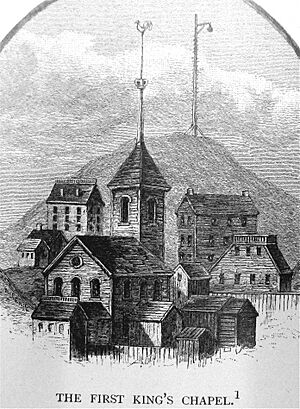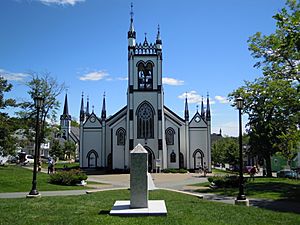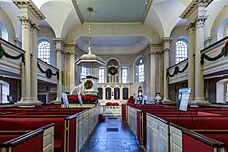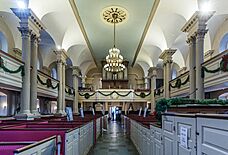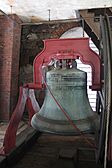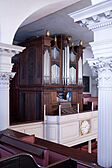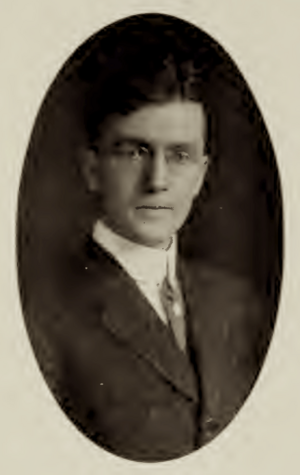King's Chapel facts for kids
|
King's Chapel
|
|
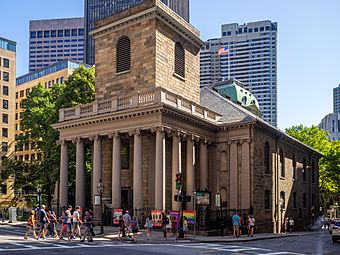
King's Chapel in Boston in August 2019
|
|
| Location | Tremont and School Streets, Boston, Massachusetts, U.S. |
|---|---|
| Built | 1754 |
| Architect | Peter Harrison |
| Architectural style | Georgian |
| NRHP reference No. | 74002045 |
Quick facts for kids Significant dates |
|
| Added to NRHP | May 2, 1974 |
| Designated NHL | October 9, 1960 |
King's Chapel is a special church in Boston, Massachusetts. It's known for its unique Christian beliefs and its beautiful old building. The church follows a "Unitarian Christian" way of thinking, which means it believes in one God, not a Trinity. Its worship style is similar to the Anglican Church, but its members make their own decisions about how the church is run.
The building itself is very old, finished in 1754. It was designed by a famous architect named Peter Harrison. Because of its amazing design, it was named a National Historic Landmark in 1960. Since 1785, the church has used its own special version of the Book of Common Prayer for its services.
Right next to the chapel is the King's Chapel Burying Ground, a very old cemetery. But even though they are neighbors, the cemetery is not connected to the church. It was there long before the current church building was even thought of!
Contents
The Story of King's Chapel
How the Church Started
King's Chapel began in 1686. It was started by the Royal Governor, Sir Edmund Andros, during the time of King James II. This was the very first Anglican Church in the New England colonies.
The first King's Chapel was a wooden church built in 1688. It stood right where the stone church is today, at the corner of Tremont and School Streets. It was built on a public cemetery because no one wanted to sell land for a church that wasn't Congregationalist. At that time, the Congregational church was the official religion in Massachusetts.
Building the Stone Church
In 1749, work began on the stone church you see today. It was designed by Peter Harrison. What's really cool is that the new stone church was built around the old wooden one! Once the stone church was finished in 1754, the wooden church was carefully taken apart. Its pieces were then moved out through the windows of the new stone building.
The wood from the old church was shipped all the way to Lunenburg, Nova Scotia. There, it was used to build St. John's Anglican Church. Sadly, that church was destroyed by fire in 2001, but it has since been rebuilt. The original plan for King's Chapel included a tall steeple, but they never had enough money to build it.
Changes After the American Revolution
During the American Revolution, many families who supported the King (called Loyalists) left Boston. They went to places like Nova Scotia or England. Because of this, King's Chapel was empty for a while and was simply called the "Stone Chapel."
In 1782, the church reopened. It became a Unitarian church under the leadership of James Freeman. In 1785, Freeman changed the old Book of Common Prayer to fit Unitarian beliefs. Even though Freeman thought King's Chapel was still Episcopalian, the first Episcopal bishop, Samuel Seabury, would not officially make him a priest. Today, the church still uses its own special Anglican-style services. It is now part of the Unitarian Universalist Association.
Inside King's Chapel
Inside King's Chapel, you'll see beautiful wooden columns. These columns have fancy tops called Corinthian capitals. They were carved by hand in 1758 by William Burbeck and his helpers. The pulpit (where the minister speaks) and the wooden panels behind the altar are even older. They came from the first wooden church!
The church has special seating called box pews. In the past, families owned these pews. They would pay rent for them and even decorate them how they liked. There were also extra seats in balconies on the sides. The pews look the same today because they were all made uniform in the 1920s.
One special seat is Pew No. 30, known as the Governor's Pew. It was originally saved for the Royal Governor of Massachusetts. Later, on October 27, 1789, George Washington himself sat in this very pew!
Music and the Bell
Music has always been important at King's Chapel. The church got its first organ in 1713. Over the years, several different organs have been installed. The current organ, the sixth one, was built in 1964 by C.B. Fisk. It even has decorations from an older organ from 1756. For 42 years, a famous American composer named Daniel Pinkham was the organist and music director here.
The King's Chapel bell was made in England and hung in 1772. In 1814, it cracked. So, it was recast (melted down and made new) by Paul Revere and Sons. This bell is the largest one ever made by Revere's company, and it was the last one made during Paul Revere's lifetime. It has been rung for services ever since!
Inside the chapel, there's also a monument to Samuel Vassall. He was a London merchant who stood up against King Charles I's taxes. He later became a Member of Parliament.
Ministers of King's Chapel
Many ministers have led the King's Chapel congregation over the centuries. Here are some of the people who served as ministers:
- Robert Ratcliff, 1686–1689
- Samuel Myles, 1689–1728
- Roger Price, 1729–1746
- Henry Caner, 1747–1776
- James Freeman, 1787–1836
- Samuel Cary, 1809–1815
- F.W.P. Greenwood, 1824–1843
- Ephraim Peabody, 1845–1856
- Henry Wilder Foote, 1861–1889
- Howard Nicholson Brown, 1895–1921
- Harold Edwin Balme Speight, 1921–1927
- John Carroll Perkins, 1927–1933
- Palfrey Perkins, 1933–1953
- Joseph Barth, 1953–1965
- Carl R. Scovel, 1967–1999
- Charles C. Forman, 1980–1998
- Matthew M. McNaught, 1999–2001
- Earl K. Holt, 2001–2009
- Dianne E. Arakawa, 2009–2013
- Joy Fallon, 2013–present
Images for kids
See also
 In Spanish: King's Chapel (Boston) para niños
In Spanish: King's Chapel (Boston) para niños


